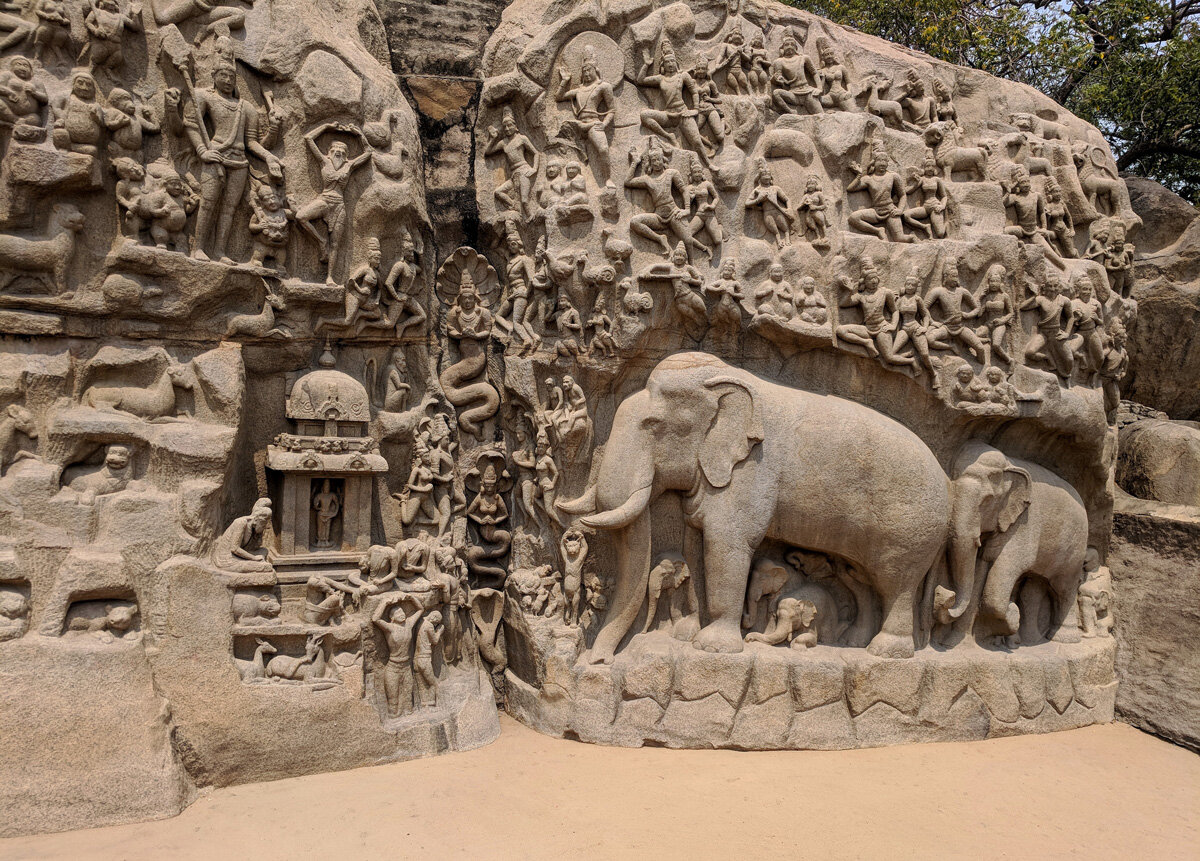Mamallapuram-Tamil Nadu, India
What is it - Throughout India, there are numerous archaeological sites with elaborate temples and carvings commemorating religious traditions and the accomplishments of various rulers from long-lost kingdoms and principalities. Westerners usually visit the better-known monuments and forts of the Great Mughals or the Rajput’s in northern India, or the older rock-cut caves with Hindu, Buddhist, and Jain carvings at Ellora and Ajanta, located northeast of Mumbai. However, there are also archaeological gems located in southern India such as the fabled city of the independent Hindu Vijayanagar Kings at Hampi who dominated southern India from the early 1300s to around 1600.
One of the more unique and interesting ruins to visit in southern India is the seaside temples and monuments of Mamallapuram located on the coast south of Chennai. Mamallapuram flourished as a seaport and major city of the Pallavas rulers of Southeast India during the 4th to 7th century. In addition to building a religious and educational center in their capital of Kanchipuram which remains to this day, the Pallavas were great traders. They enhanced the South's maritime tradition which allowed the region to trade for centuries thereafter with the Arab world, the kingdoms of Southeast Asia and later the Europeans.
People do not come to Mamallapuram for the history but for the majesty of its monuments and the artistry of its stone carvings. Perhaps the best-known site is the Shore Temple dedicated to both the Hindu gods Vishnu and Shiva, which is located on a small peninsula jutting out into the Bay of Bengal. Several polished shrines to the gods are located within raised platforms and surrounded by elaborately carved walls and 16 statues of bulls. The Shore Temple location has survived the pounding surf nearby over the centuries, but archeologist believe that other buildings may be submerged nearby because of stone uncovered during the 2004 tsunami.
A few hundred yards inland is an intriguing series of five huge boulders which were carved into temples roughly resembling gods on chariots and several animals. Generally known as the Pancha Rathas, these interesting carvings extend for several hundred feet and offer a shaded area to relax and contemplate the story being depicted by the site. Ironically, this ruin was unknown to locals and buried in the sand until located by the British and excavated in the 1800s.
As you proceed into town, the geography of the area turns hilly with shops and streets surrounded by mountains of ledge. A large portion of these ridges have been carved out into temples and shrines. But the most spectacular work of the Pallavas’ craftsmen is a 50-foot-high rock face known as Arjuna’s Penance or the Descent of the Ganges. This relief carved into the rock shows about 50 different kinds of animals and people crowded around the sacred river Ganges which is flowing down around them. Interpretations of the work vary. Some people believe it displays humans, animals and mythical snake-like nagas fighting among themselves and with each other until they drink from the river, before learning to coexist in harmony thereafter. The likenesses are striking, and the workmanship rivals the work produced by the sculptors of the renaissance.
There are many other interesting natural formations and panels to look at including a boulder known as the butterball which hangs precariously on a ledge and attracts dozens of children, as well as some carving of tigers and elephants, and the possible ruins of a palace.
How to Get There - Chennai is the fourth largest city in India with a population close to 7 million people and serves as the gateway for tourists visiting the area. Chennai is a modern city with some interesting temples, British colonial landmarks, an incredibly wide and festive beachfront, and a church dedicated to the Apostle Thomas who was buried there according to the church. Major airlines including Emirates, Singapore Air, British Airways and Air India fly to Chennai.
When to Go - October and November are the rainy months in the southeast when the monsoon rains are heavy, so travel is best avoided then. The rest of the year has infrequent rainy days. However, the temperature hits 90 degrees by March each year and stays there until late November when it eases a bit, so people in the area flock to the beaches and the ocean throughout most of the year.
Where to Stay- Most people who visit Mamallapuram come for the day by driving for about two hours down from Chennai or up from Pondicherry. The village located in and around Mamallapuram is small and the people are friendly. There are several decent hotels located along the water up the beach from the Shore Temple which offer a relaxing alternative to an overnight trip to the site along with a relaxing pool and the ocean breeze. These include Radisson Blu, Intercontinental Chennai Mamallapuram and Four Points by Sheraton. If staying in Chennai, you cannot beat the luxurious Leela Palace located south of the city
Cost – The entry fee to all the sites at Mamallapuram is less than $4 per person for non-Indian visitors.





